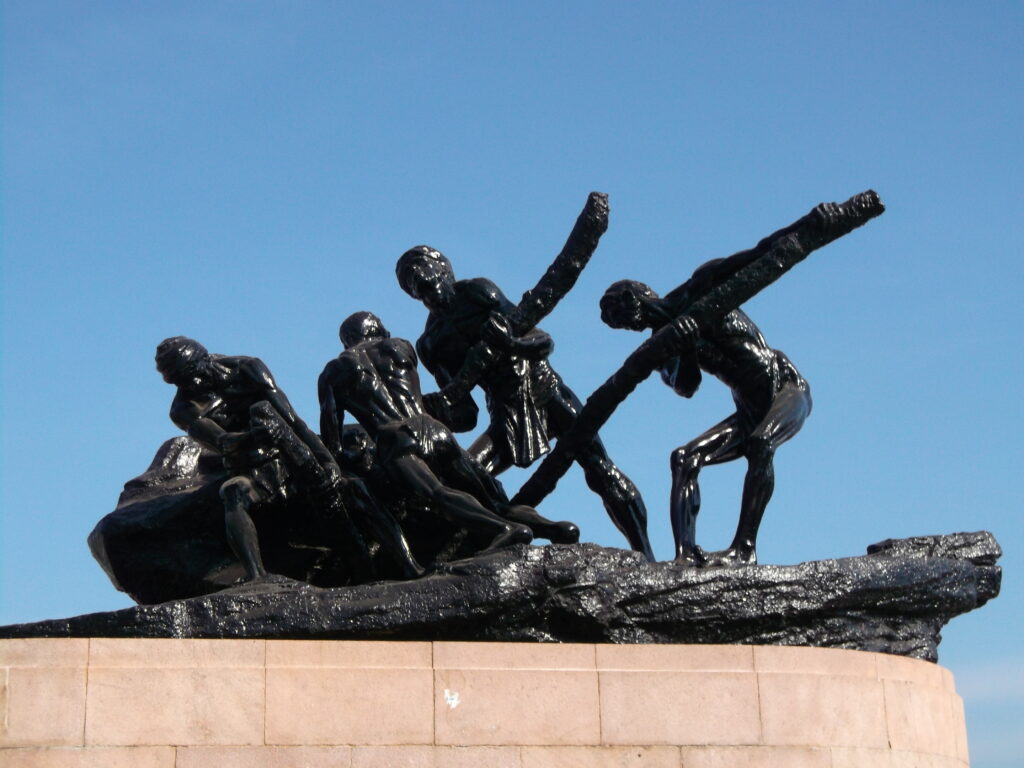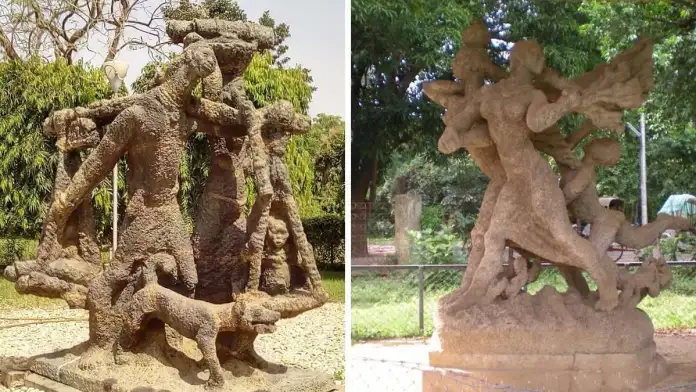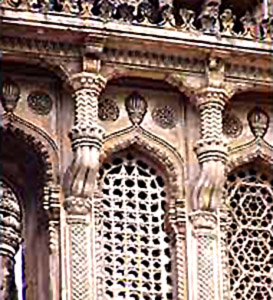The tradition of Indian sculpture extends from the Indus valley civilization of 2500 to 1800 BCE, during which time small terra -cotta figurines were produced. The great circular stone pillars and carved lions of the Mauryan period (3rd century BCE) gave way to mature Indian figurative sculpture in the 2nd and 1st centuries BCE. A wide range of styles and traditions subsequently flourished in different parts of India over the succeeding centuries, but by the 9th—10th centuries CE Indian sculpture had reached a form that has lasted with little change up to the present day. This sculpture is distinguished not by a sense of plastic volume and fullness but rather by its linear character; the figure is conceived from the standpoint of its outline, and the figure itself is graceful, slender, and has supple limbs.
Features of Indian Sculpture
- Features of Indus Valley sculptures were entirely disjointedly dissimilar from the later ages. The Terracotta sculptures or architectural adornments of the style of Indus Valley are unique.
- Features of Vedic Indian sculpture were also unique but were rural. Mauryans emerged in Magadha. The features of the Mauryan sculpture were mirrored mainly in the religious monuments that were erected during the dynasty. The features of Gupta sculpture are found in the cave temples of India. These cave temples include Ajanta and Ellora .
- The South Indian temples witnessed a new – fangled sort of approach from 200 CE onwards, whether this approach was with features of Chalukya sculptures or the features of Pallava sculptures. The features of Badami Chalukya sculpture developed a new expression for itself which gained fame as the Karnata Dravida style. This was also popular as the Vesara architecture and sculpture. Idioms of both – southern and northern temple building are combined in this style. The features of Western Chalukya sculptures over and over again incorporated the copiously carved mandapdas, shikharas and outer walls.
- The bronze images were one of the major features of the Chola sculptures. The Chola bronze sculptures were well-designed and put rhythmic movements on show.
- Features of sculpture in medieval India differed radically from that of primeval India. The Persian art and architecture greatly influenced the native style. With the establishment of the Slave Dynasty in 1206 AD till 1526 AD saw the evolution of the features of Delhi Sultanate sculptures and architectures. The tall pillars, tombs, arched doorways, and minarets, merged with the Indian architecture. With this merger the formation of Indo-lslamic sculptures and architecture came into being.
- The features of the Rajput sculptures hold evidence to this fact. The architectural elements of the monuments of the Rajput display that they were borrowed from Persian style of architecture.
- The features of Mughal sculpture and architecture would over and over again comprise of calligraphy, well maintained gardens, broad and complicated stone works, and the recurrent use of marble .
- The originality for which sculptures of India were wonderfully distinguished at a time has not changed. At that time also India was blessed with astonishing talents and the contemporary India is once again a powerhouse of architectural and sculptural talent.
- Sculpture has gradually evolved into installations and taken a modern character. No wonder, features of Indian sculpture are a source of versatility and varied expression and continue to be the same.
Indus Valley Civilization Sculpture
The Harappan sculptors were extremely adept at handling three-dimensional volumes. The forms of art excavated include various sculptures, seals, pottery, gold jewellery, terracotta figures, and other interesting works of art.
Metal Sculptures of Indus Valley Civilization
- The Harappan artisans were dexterous in the sphere of bronze casting and employed the lost wax process while sculpting figurines.
- Lost-wax process, also called cire-perdue is a method of metal casting in which a molten metal is poured into a mold that has been created by means of a wax model. Once the mold is made, the wax model is melted and drained away. A hollow core can be effected by the introduction of a heat-proof core that prevents the molten metal from totally filling the mold.
- The bronze dancing girl statue discovered at Mohenjodaro is perhaps the greatest surviving achievement of the metal work of the Harappan age. This world-famous figure shows a female dancing figure standing as if relaxing after a dance, with her right hand on her hip and the left dangling free. She wears a large number of bangles, probably made of bone or ivory on her left arm together with a couple of pairs on her right arm.
- Bronze figures of a humped bull and a buffalo are the other metal sculptures made during this period.
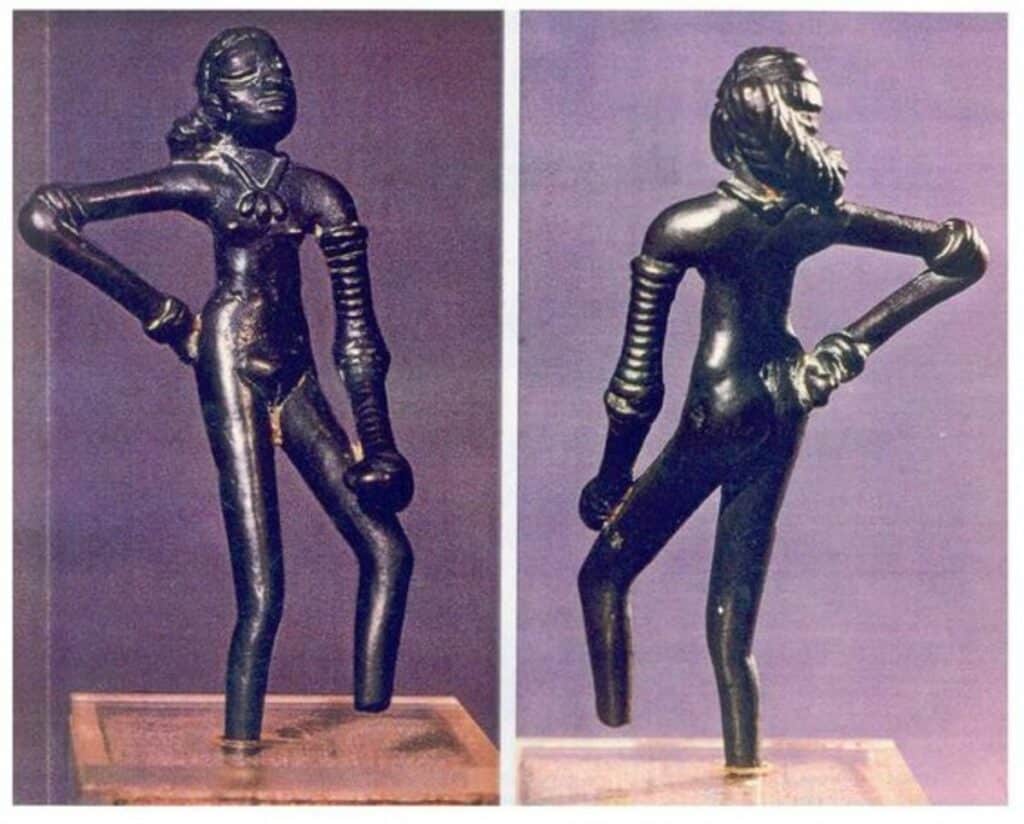
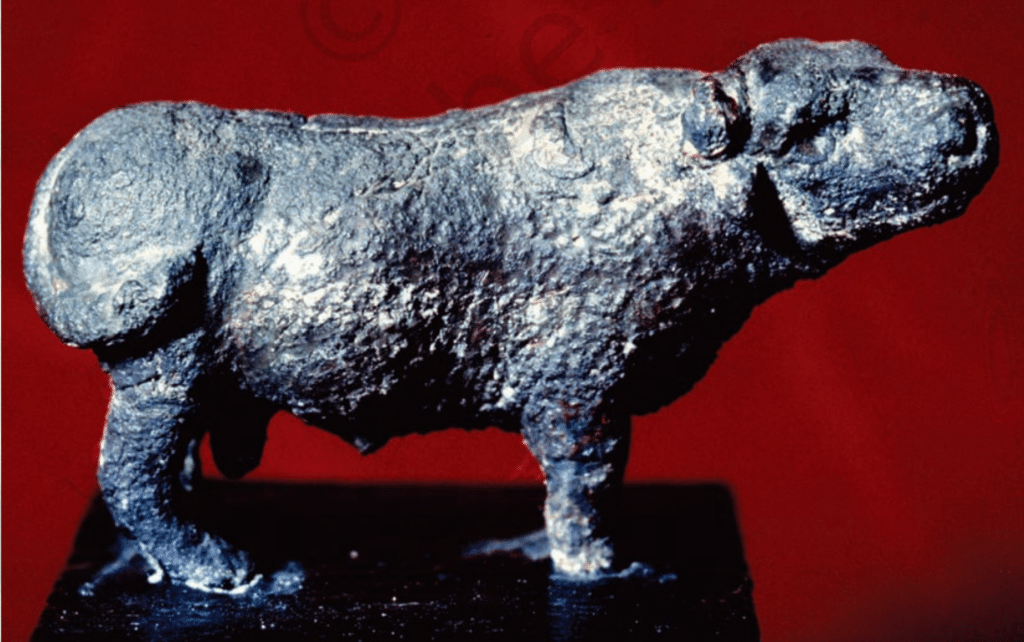
Stone Sculptures of Indus Valley Civilization
- Several specimens of stone sculptures which were crafted during the civilization have been excavated. Out of these, two statues deserve a special mention and consist of the statue of the ‘Bearded Man’ and ‘Human Torso’.
- One will derive the idea of a high priest or a king clad in a shawl draped over the left shoulder, with a well maintained beard, if he observes the figure of the Bearded Man. Found in Mohenjodaro, it was made of Steatite
- Another impressive stone sculpted statue is that of a naked human male torso, made in red stone. The arms and head of this idol have been created separately. It was found in Harappa.
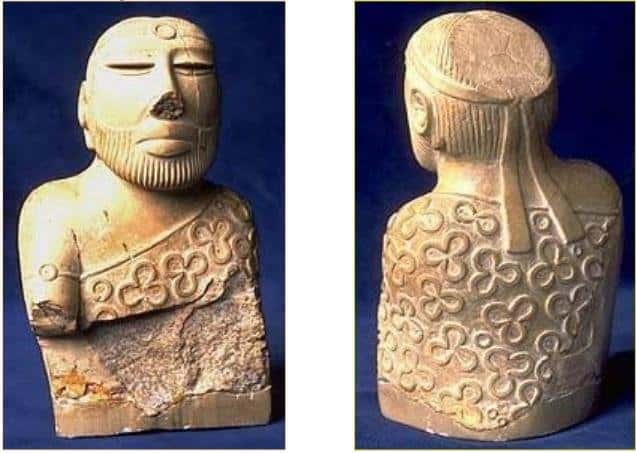
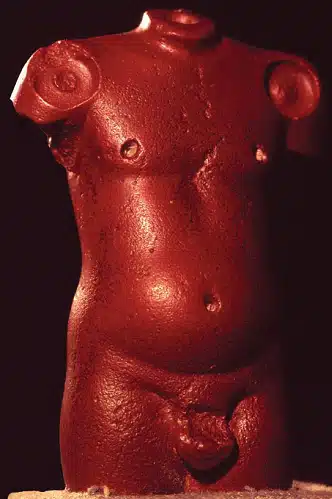
Terracotta Sculpture of Indus Valley Civilization
- Terracotta art was also practised by the people of Indus Valley.
- The figure of the Mother Goddess crafted in terracotta, discovered in Mohen-jo-Daro is one of the significant terracotta sculptures of this age.
- It consists of beautiful embellishments of the body and a punched nose, and reveals the concept of the Mother Goddess as a sign of prosperity and fertility.
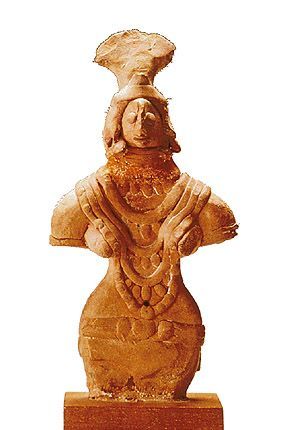
- Terracotta seals were also manufactured. These seals included the carvings of peepal leaves, female figurine with forms of deities and animals.
- The toy animal, with a moveable head from Mohenjodaro, belonging to the same period i.e. 2500 BCE, is one of the most interesting objects found during the excavations.
- Large number of seals made of steatite, terracotta and copper of various shapes and sizes have also been discovered.
- The standard Harappan seal was a square plaque 2x 2 square inches, usually made from the soft river stone, steatite.
- Seals bear a great variety of motifs, most often of animals including those of the bull, with or without the hump, the elephant, tiger, goat etc. Sometimes trees or human figures were also depicted. The most remarkable seal is the one depicted with a figure in the centre and animals around. This seal is identified as the Pashupati Seal. This seal depicts a human figure seated cross-legged. An elephant and a tiger are depicted to the right side of the seated figure, while on the left a rhinoceros and a buffalo are seen. In addition to these animals two antelopes are shown below the seat.
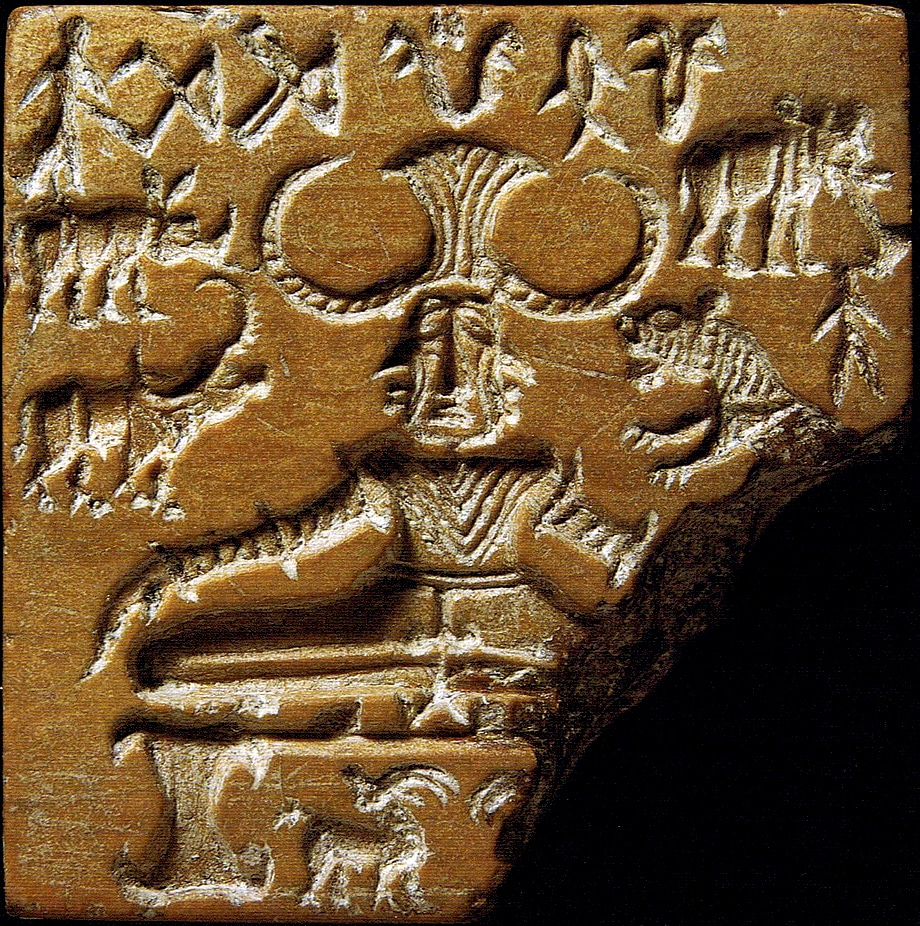
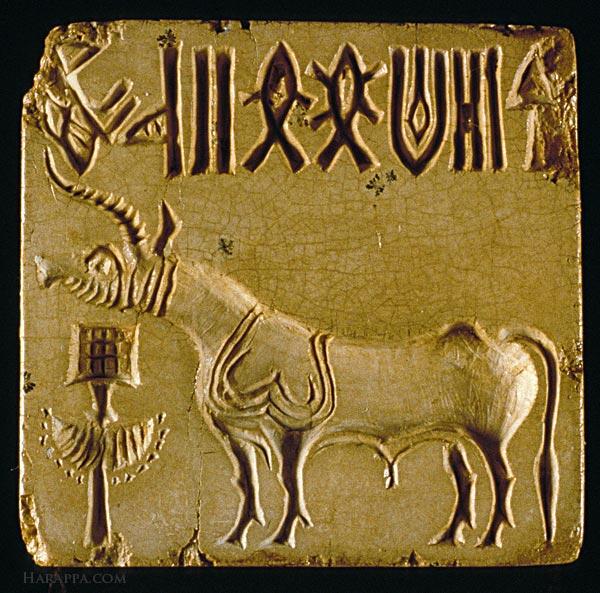
Beads and Ornaments
- The Harappan men and women decorated themselves with a large variety of ornaments produced from every conceivable material ranging from precious metals and gemstones to bone and baked clay.
- The bead industry seems to have been well developed as evident from the factories discovered at Chanhudaro and Lothal. Beads were made of cornelian, amethyst, jasper, crystal, quartz, steatite, turquoise, lapis lazuli, Ancient stwrM in Sanchi etc.
- Metals like copper, bronze and gold, and shell, faience and terracotta or burnt clay were also used for manufacturing beads. The beads are in varying shapes—disc-shaped, cylindrical, spherical, barrelshaped, and segmented. Some beads were made of two or more stones cemented together, some of stone with gold covers. Some were decorated by incising or painting and some had designs etched onto them. Great technical skill has been displayed in the manufacture of these beads.
- The Harappan people also made brilliantly naturalistic models of animals, especially monkeys and squirrels, used as pin-heads and beads.
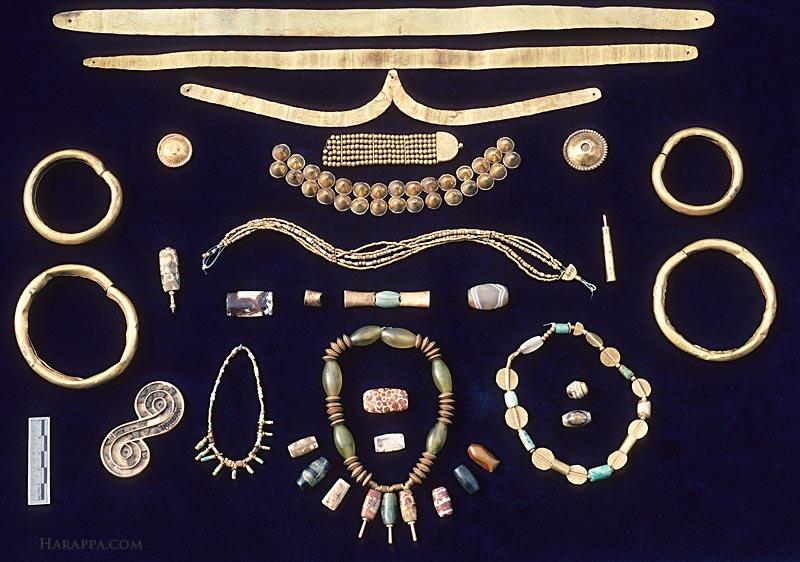
Pottery:
- The potteries found at the excavation sites can be broadly classified into two kinds – plain pottery and painted pottery. The painted pottery is also known as Red and Black Pottery as it used red colour to paint the background and glossy black paint was used to draw designs and figures on the red background. Trees, birds, animal figures and geometrical patterns were the recurring themes of the paintings.
- Most of the potteries that have been found are very fine wheel-made wares, with a very few being handmade. Some examples of polychrome pottery have also been found, though very rare. The potteries were used for three main purposes:
- Plain pottery was used for household purposes, mainly storage of grains and water.
- Miniature vessels, generally less than half an inch in size, were used for decorative purposes.
- Some of the potteries were perforated – with a large hole in the bottom and small holes across the sides. They might have been used for straining liquor.
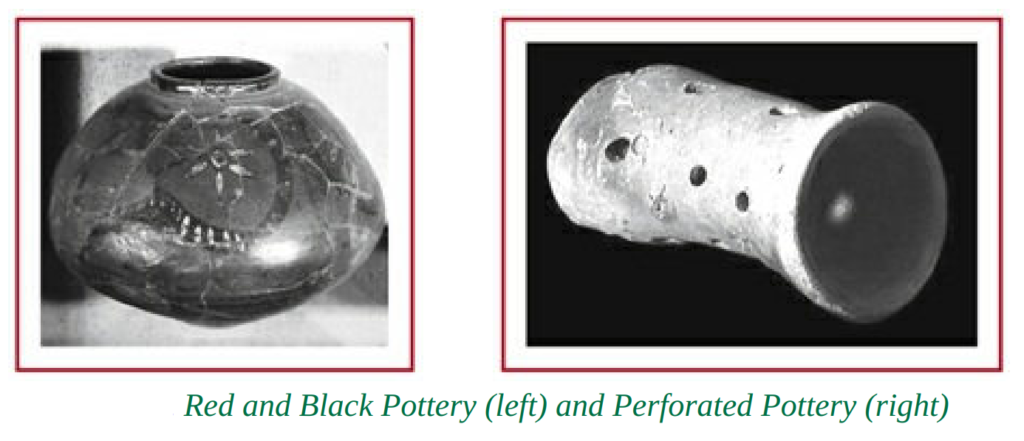
Mauryan Empire Sculptures
Mauryan sculpture introduced new things in Indian sculpture like the introduction of stone and brick sculptures in place of wooden sculptures. Most of the Mauryan sculptures are related to Buddhism. This can be attributed to Emperor Ashoka. After converting to Buddhism, Emperor Ashoka had built several Buddhist buildings and sculptures. Some of Ashoka’s edicts carved on pillars and rocks made out of shafts of sandstone, represent the earliest known stone sculptures in our country.
Foreign Influence on Mauryan Sculpture
- An adaptation of Achaemenids models has been recognised in the Edicts of Asoka. But, the Mauryan pillars are different from the Achaemenid pillars. The Mauryan pillars are rock-cut pillars, whereas the Achaemenid pillars are constructed in pieces by a mason.
Stupa Sculpture of Mauryan Empire
- The ‘stupas’ are solid dome like structures built with bricks and stones and they were initially created as symbols of artistic tradition in Mauryan Dynasty.
- The greatest instances of the architecture of the Mauryan period is the great Sanchi Stupa, Madhya Pradesh, surrounded by exquisitely carved stone railings around it.
- It is also famous and notable due to the four gateways called Toranas, since before this there was no such tradition of carving gateways. These gateways are elaborately carved and depict the various scenes from the life of Buddha and also about the lifestyle of people in that era.
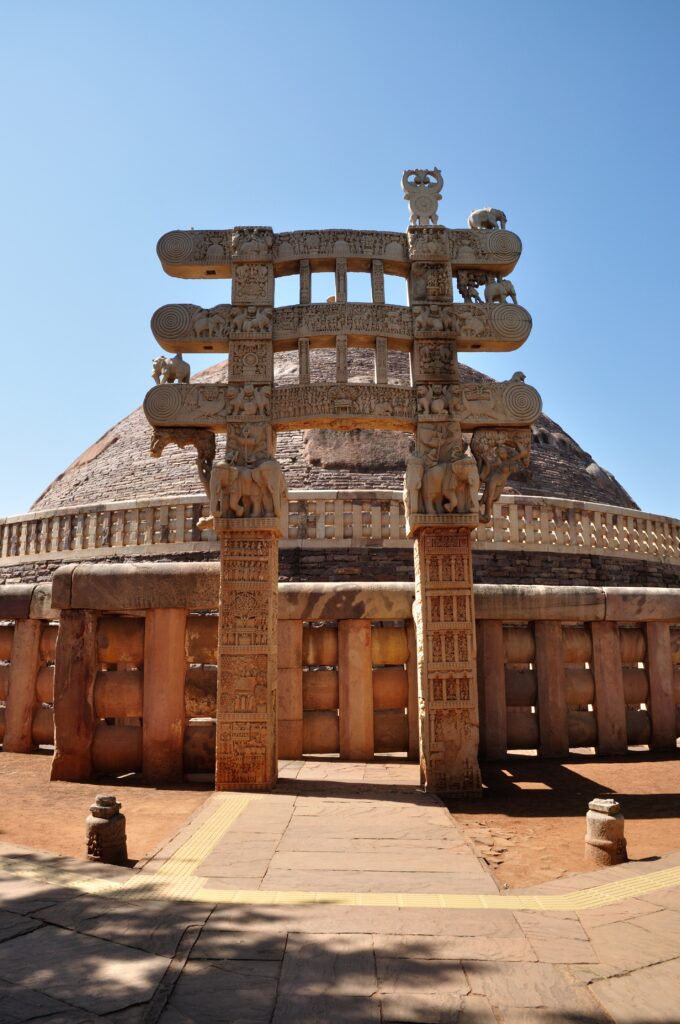
Pillar Sculptures of Mauryan Empire
- The Pillars were one of the major works accomplished by Emperor Ashoka.
- The most famous Lion Capital (pillar showing fourlions) erected by Ashoka at Sarnath in sandstone realistically represents the artistic achievements of Indian artists and patronage of their masters.
- Two kinds of stone had been employed in the creation of the pillars which consisted of fine grained hard sandstone of Chunar region close to Varanasi as well as spotted white and red sandstone belonging to Mathura.
- Inscriptions containing principles of ‘Dhamma’ or righteousness were embedded on all these pillars. The Lion Capital at Lauria Nandangarh and Bull Capital of Rampurva are impressive sculptural art which evolved during the Mauryan Empire.
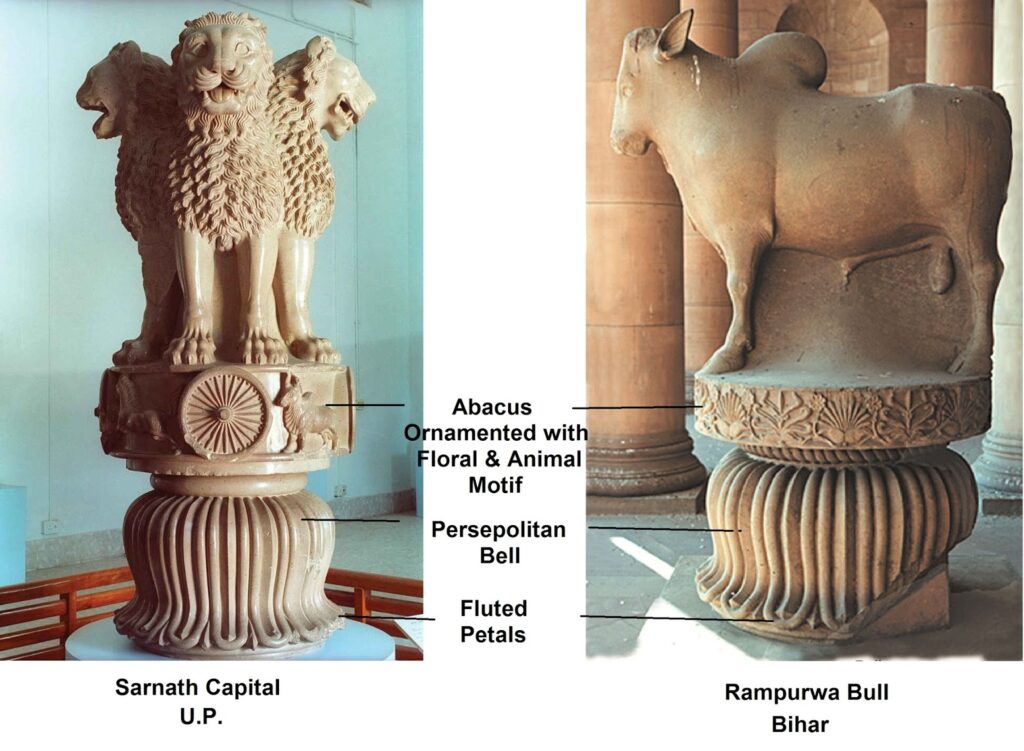
Figurine Sculptures of Mauryan Empire
- The whisk- bearer of Didarganj, female ‘Yakshi’ figurine of Besnagar and the male statue at Parkham are some of the famous figurine sculptures of Mauryan Empire.
- Numerous terracotta idols were also sculpted by the artisans and clay idols of Mother Goddesses have been discovered by some excavations conducted at Ahicchatra.
- The rock cut sculpture of Elephant in Dhauli, near Bhubneshwar in Odisha represents the fore-part of an elephant carved over the Edicts of Asoka, including the two specially meant for Kalinga.
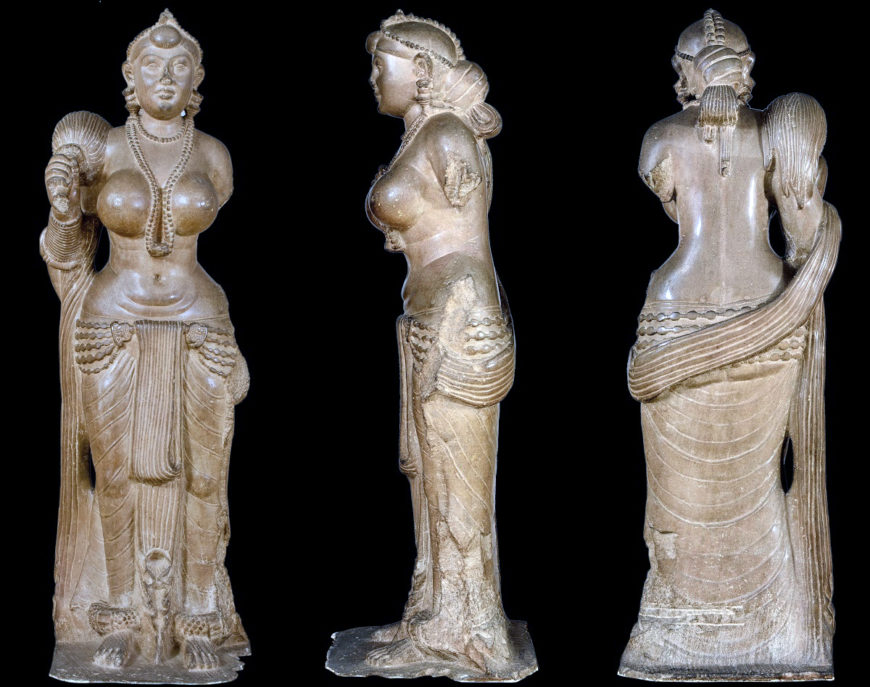
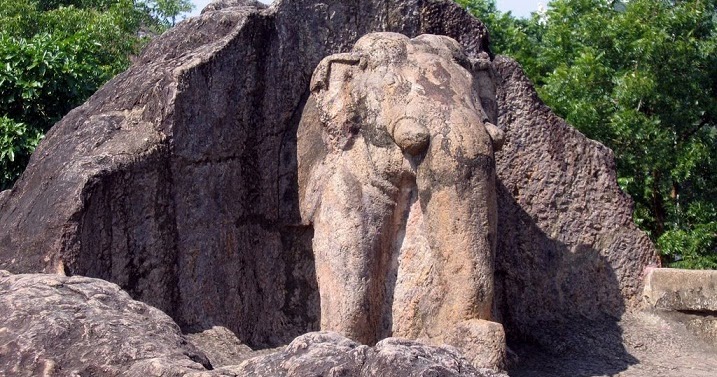
Post Mauryan Empire Sculptures
In contrast to the Mauryan period the period between 200. BCE and 300 CE was an age of small kingdoms many of them foreign in origin. Important among them are Sungas, Kanvas, Satavahanas and Kushanas.
Sculptures of Kushana Empire
Sculptures of Kushan Empire had two distinctive styles:
- Northern one in the Gandhara region known as the Gandhara School.
- Southern one in Mathura known as the Mathura School.
Sculptures of Gandhara School
- The Gadhara region extending from Punjab to the borders of Afghanistan was an important centre of Mahayana Buddhism up to the 5th century CE.
- Owing to its location the Gandhara School imbibed all kinds of foreign influences like Persian, Greek, Roman, Saka and Kushan.
- The Gandhara School of sculptures is also known as the Graeco-Buddhist School of Art since Greek techniques of Art were applied to Buddhist subjects.
- The most important contribution of the Gandhara School of Art was the evolution of beautiful images of the Buddha and Bodhisattavas, which were executed in black stone and modelled on identical characters of Graeco-Roman pantheon.
- Important characteristics of Gandhara school are:
- Depiction of Lord Buddha in the standing or seated positions.
- The seated Buddha is always shown cross-legged in the traditional Indian way.
- Rich carving, elaborate ornamentation and complex symbolism.
- Use of Grey stone and mainly Buddhist imagery.
- The best specimens of Gandhara art are from Jaulian and Dharmarajika stupa at Taxila and from Hadda near Jalalabad in modern Afghanistan. The tallest rock-cut statue of Lord Buddha is also located at Bamiyan in modern Afghanistan.
- Gandharan sculptures show strong Greek influences in the depiction of a ‘man-god ’ and of wavy hair, sandals and extensive drapery. Stucco plaster, which was commonly observed in Greek art , was widely used in Gandharan art work .
- However, Gandharan sculpture owes to Roman art too. Some of the features of Classical Roman art observed in Gandharan sculptures are vine scrolls, cherubs with garlands , tritons and centaurs. The draping of the robes on Buddha was also taken from Roman sculptures.
Sculptures of Mathura School of Art
- The Mathura School of art flourished at the city of Mathura between 1-3 CE and was promoted by the Kushans. It established the tradition of transforming Buddhist symbols into human form.
- Important characteristics of Mathura school are:
- They were depicted as strongly built with the right hand raised in protection .
- The figures produced by this school of art do not have moustaches and beards as in the Gandhara Art.
- Spotted Red sand stone mainly used.
- It not only produced beautiful images of the Buddha but also of the Jain Tirthankaras and gods and goddesses of the Hindu pantheon .
- Buddha is shown to be surrounded by two Bhodisattavas, Padampani holding a lotus and Vajrapani holding a thunder bolt.
Sculptures of Amaravati School of Art
- Amaravati School of art and sculpture evolved during the Satavahna period. Amaravati is situated on the banks of the Krishna River.
- It is the site for the largest Buddhist Stupa of South India.
- This school of art had great influence on art in Sri Lanka and South-East Asia as products from here were carried to those countries.
- Characteristic features of Amravati school are:
- In the initial periods, Lord Buddha is depicted in the form of ‘Swastika’ mark. This has been carved out on the cushioned seat over a throne that is situated under the Bodhi tree.
- At a later stage the Amaravati School depicted Buddha in the human form.
- The figures of Amaravati have slim blithe features and are represented in difficult poses and curves. However the scenes are over-crowded.
- Use of white marble.
- The images of Lord Buddha from Alluru, Dharma Chakra from Lingaraja Palli, Bodhisattvas are some of the finest instances of the Amaravati School of art and sculpture.
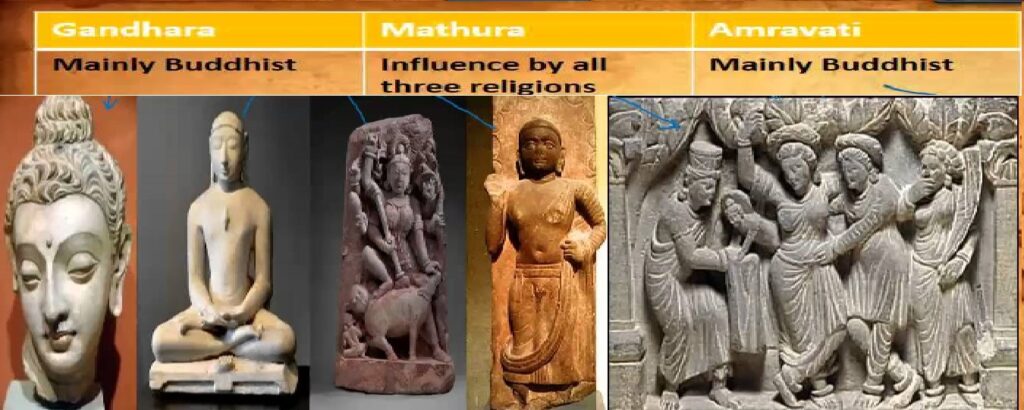
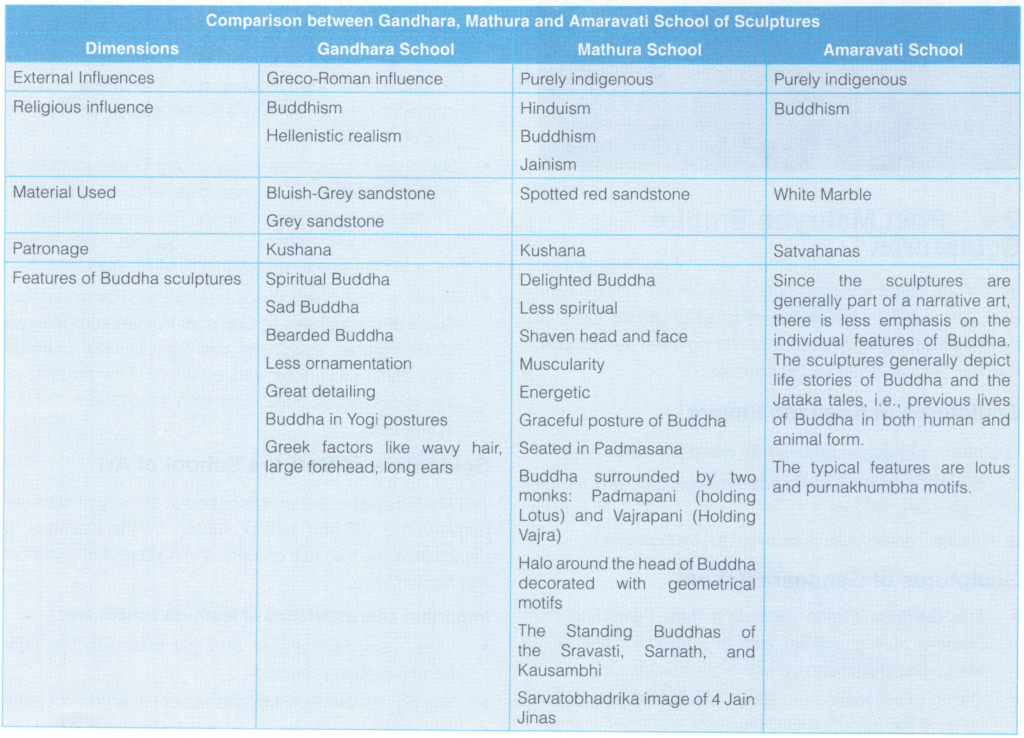
Sculptures of Gupta Empire
- Gupta sculpture is the logical outcome of the sculpture schools of Amravati and Mathura. Its grace is derived from that of Mathura and its elegance from that of Amravati.
- With time the art of Bharhut, Amravati, Sanchi and Mathura came closer and closer; melting into one.
- The human figure, taken as the image, is the pivot of Gupta sculpture. A new canon of beauty is evolved. The soft and pliant body of Gupta sculpture with its smooth texture facilitates free and easy movement.
- The transparent clinging drapery became the trend of this age. However the sensuous effect was restrained by a conscious moral sense and nudity was eliminated from Gupta sculpture.
- Halo around Buddha was intricately decorated.
- The magnificent red sandstone image of the Buddha from Mathura is a great example of Gupta workmanship datable to the 5th century CE Buddha is shown here standing with his right hand in abhayamudra, assuring protection, and the left holding the border of the garment .
- The image of the standing Buddha is an excellent example of Gupta art in its maturity from Sarnath. The softly moulded figure has its right hand in the attitude of assuring protection.
- Sarnath introduces not only a delicacy and refinement of form but also a relaxed attitude by bending the body in the case of the standing figure, slightly on its own axis, thus imparting to it a certain litheness and movement in contrast to the columnar rigidity of similar Mathura works. The folds have been discarded altogether; an indication of the drapery only survives in the thin lines on the body suggesting the edges of the garment. The body in its smooth and shining plasticity constitutes the principal theme of the Sarnath artists.
- Ganga and Yamuna, two life – sized terracotta images, originally installed in niches flanking the main steps leading to the upper terrace of the Shiva temple at Ahichhatra, belong to the Gupta period 4th century CE
- Clay figurines (Terracottas) have great value as sources of social and religious history. The Head of Shiva is an elegant example of Gupta terracottas, depicted with matted locks, tied in a prominent and graceful top knot. The expression on the face is noteworthy and both the figures, of Shiva as well as Parvati, are two of the most charming specimens from Ahichhatra.
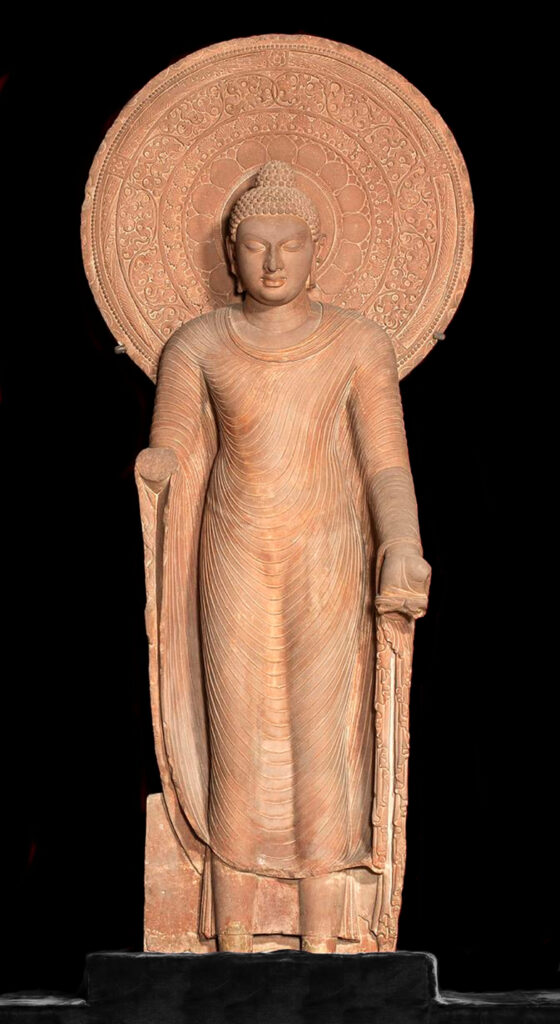
Sculptures of Pala School
- Origin of Pala sculpture can be attributed to the late Gupta style.
- However at a later stage the Pala style drifted away from its origin and developed its own style. The deviation was due to the fusion of classical mannerism with the indigenous style of Bengal.
- Later, more importance was given to vegetable decoration, ornamentation. Faces became more pointed. Excepting a few most of Pala sculptures of eleventh and twelfth century are stereotyped .
- These sculptures were built in such a way so that they could stand the rough weather. The sculptures of the deities were carved out of fine grained black stones.
- Terracotta is a key feature of Pala sculpture. The terracotta plaques have been used to decorate the surface of the walls.
- Bangla Roof: One of the most prominent feature of the Pala School was the shape of the sloping or curving side of the bamboo roof of a Bengali hut.
Sculptures of Chalukyas
The Chalukya dynasty was an Indian royal dynasty that ruled large parts of southern and central India between the 6th and the 12th centuries . During this period , they ruled as three related yet individual dynasties. These are:
- Badami Chalukyas
- Western Chalukyas (Chalukyas of Kalyani)
- Eastern Chalukyas (Chalukyas of Vengi )
Badami Chalukya Sculptures
- Badami sculptures closely resembled the Dravidian architecture. Two kinds of monuments developed under the Badami Chalukyas: rock-cut temples and structural temples.
- The features of Badami Chalukya sculpture include intricate stone works and outstanding figurines. Soapstone was widely used as the building material. Columned halls, pillared verandahs and ‘garbhagrihas’ are the main architectural elements of the Badami Chalukyas.
- The Badami Chalukya style of sculpture is a brilliant fusion of the Dravidian and Nagara styles of architecture and sculpture. Badami Cave Temple is one of the excellent examples of the fusion style of sculpture.
- The temples of Pattadakal, six of which boast of Dravidian architecture are also attractive instances of Badami Chalukya sculptures.
- Sculptures of Badami Chalukyas are quite famous and include those observed inside the premises of Sangameswarar Temple and numerable others located in Aihole, Badami, and Pattadakal. Mahakuteshwara Temple, Papanatha Temple, Galganatha Temple, Kashivisvanatha Temple, Mallikarjuna Temple which are all in Pattadakal, Lad Khan Temple and Durga Temple in Aihole, Bhutanatha Group of Temples are amongst the innumerable temples which are decorated with different artistic forms of sculptures and architectural marvels.
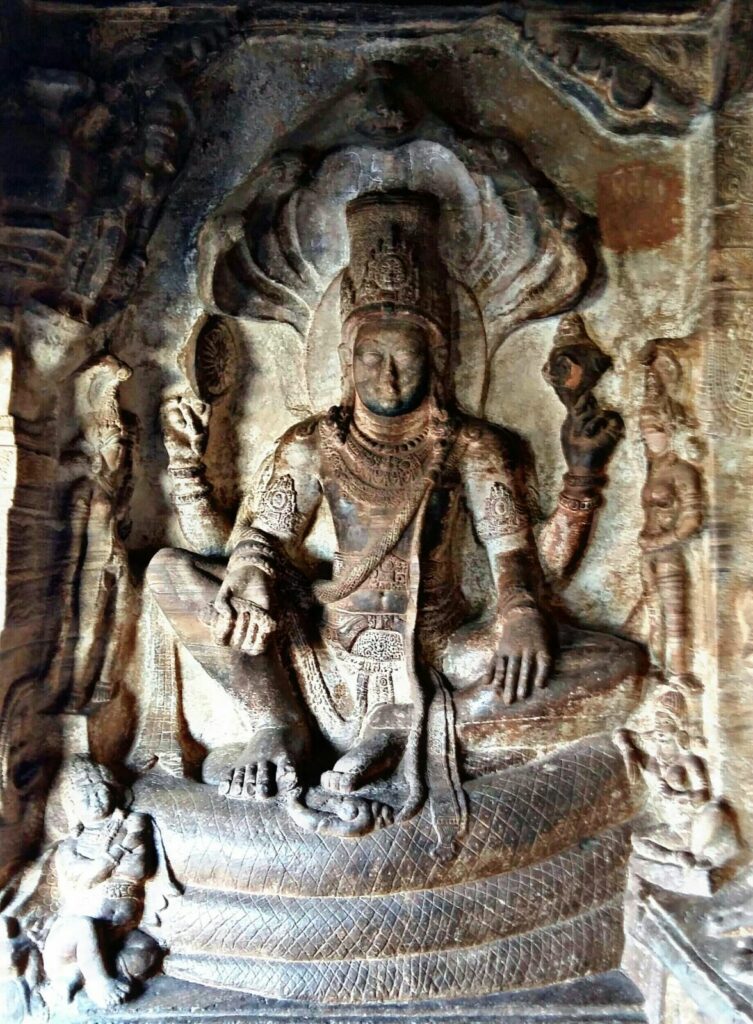
Western Chalukyan Sculptures
- Western Chalukya sculptures followed the Dravidian architecture and sculpture style.
- The main features of Western Chalukya sculptures include the intricate and detailed stone works. Beautiful images of Gods and Goddesses have been carved on stone. The ‘mandapa’, the ‘vimana’ and the ‘gopurams’ display different kinds of patterns of sculptures.
- The temples bore testimony to the brilliant Western Chalukyan sculpture. The Dodda Basappa Temple, Kalleshwara Temple and Mallikarjuna Temple, Amritesvara Temple, Siddhesvara Temple etc. are marvellous instances of the sculptures which were prevalent during the reign of the Western Chalukyan rulers.
- Three principal types of sculptures developed under the reign of the Western Chalukyas are figure sculpture, deity sculpture and sculpture of the miniature towers, belonging to the various spectacular temples of that era.
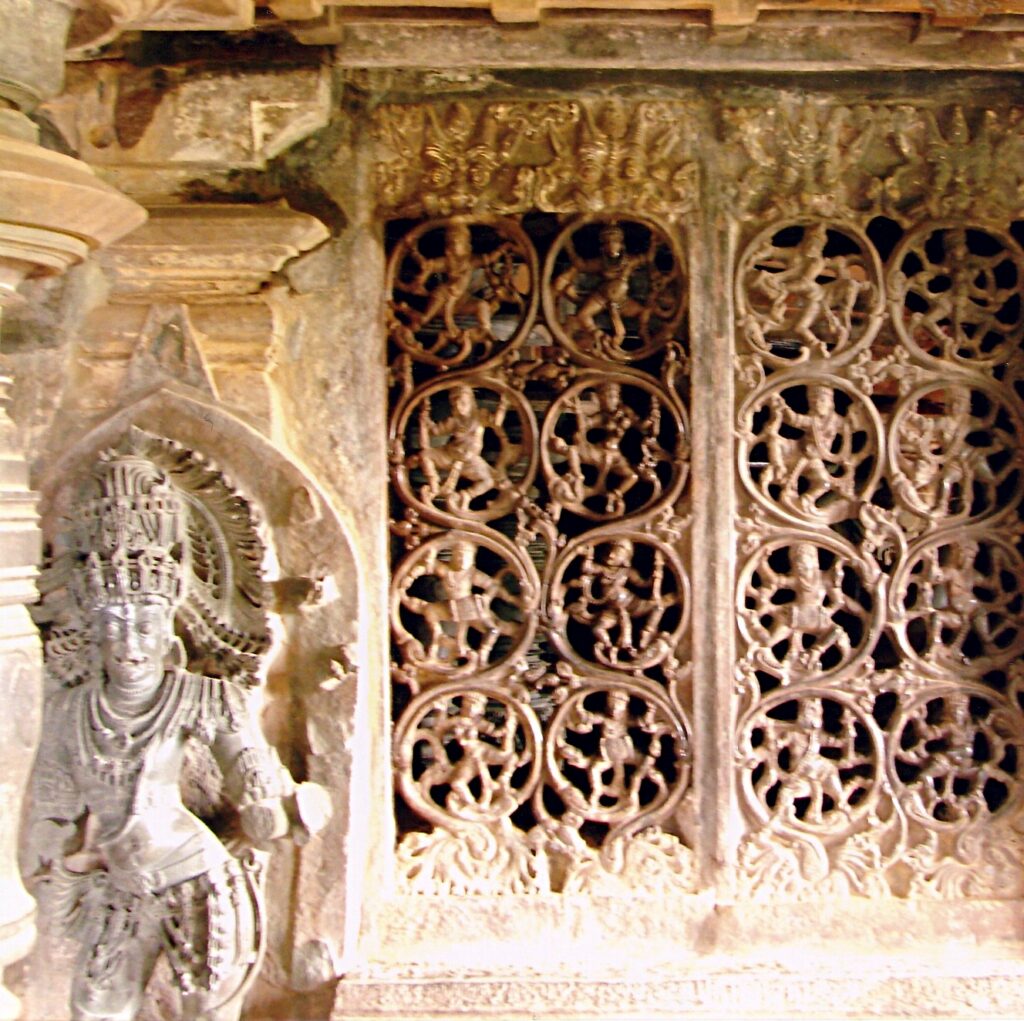
Eastern Chalukyan Sculptures
- Eastern Chalukyas, also known as the Chalukyas of Vengi, were a dynasty that ruled parts of South India between the 7th and 12th centuries.
- The Eastern Chalukyas, following the Pallavaand Chalukya traditions, developed their own independent style of architecture, which is visible in the Pancharamashrines (especially the Draksharama temple) and Biccavolu temples.
- The Golingeshvara temple at Biccavolu contains some richly carved out sculptures of deities like Ardhanarishvara, Shiva, Vishnu, Agni, Chamundi and Surya.
Rashtrakuta Sculptures
- Rashtrakuta was a royal dynasty ruling large parts of the Indian Subcontinent between the 6th and 10th centuries.
- Rashtrakuta sculptures and architectures thrived under royal patronage and are well known for their intricate carvings.
- Rashtrakuta sculpture is reflected in the splendid rock-cut cave temples at Ellora and Elephanta in Maharashtra. These caves belonged to varied religious faiths: Buddhist, Jain and Hindu (Shaiva and Vaishanava). The Elephanta caves are known for the huge three-faced icon of Mahadeva.
- The walls of many of the temples like Parameshvara temple and Brahmeshvara temple have carved sculptures depicting incidents from mythology and epics.
- One of the main features of Rashtrakuta sculptures is the variety that these present to the beholder. Their sculptures bear testimony to India’s religious unity.
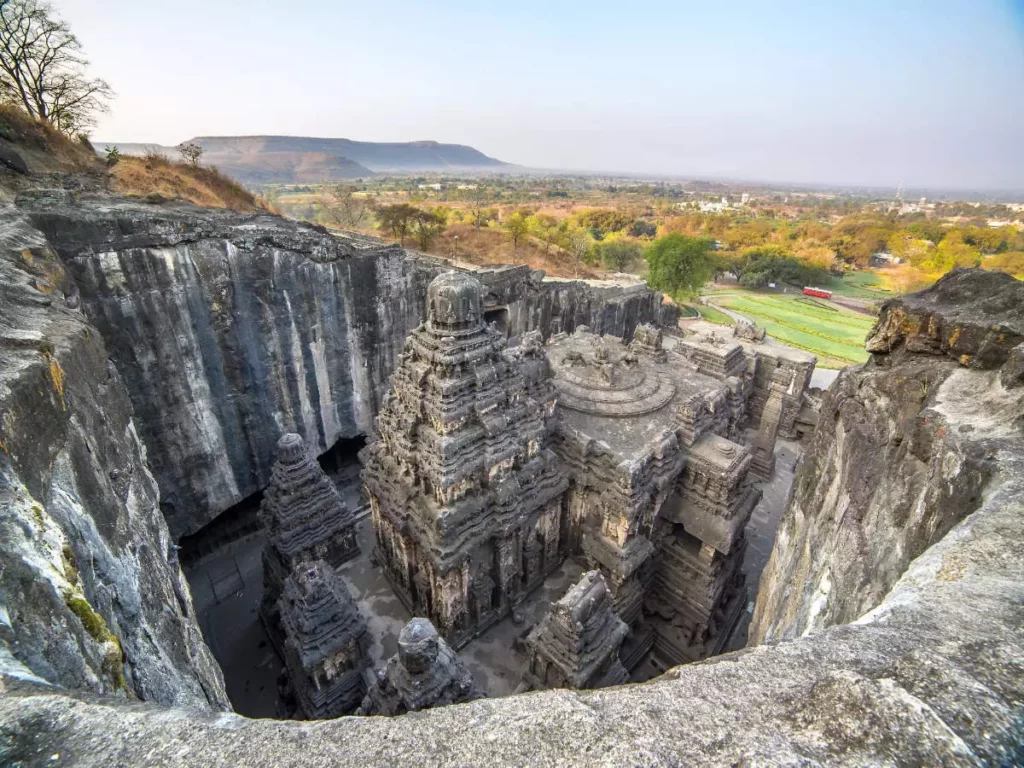
Sculptures of Hoysalas
- The Hoysala empire was a prominent Southern Indian Kannadiga empire that ruled most of the modernday state of Karnataka between the 10th and the 14th centuries.
- The Hoysala empire was preceded by the Western Chalukyas and it was succeeded by the Vijayanagara Empire.
- The Hoysala style of architecture was often referred to as an amalgamation between the Dravidian and Indo-Aryan forms.
- Thick foliage sculptures are also present on these temples. The ceilings of the mandapas are designed with prolific sculptures. The huge gateways are decorated with well carved sculptures.
- The temples at Belur, Halebeedu, Somanthapura and Doddagaddavalli are among the best specimens of Hoysala sculpture.
- Another feature of the Hoysala sculpture is erotica. The nooks and niches of the temple walls have been filled with erotic themes.

Sculptures of Vijaynagara Empire
- The Vijayanagara Empire was based in the Deccan Plateau region in South India. The empire rose to prominence by the end of the 13th century. It lasted until 1646, although its power declined after a major military defeat in 1565 by the Deccan sultanates.
- Soapstone, which was soft and easily carved, was commonly used for reliefs and sculptures. To cover the unevenness of the stone, artists employed brightly painted plaster to smooth over and finish rough surfaces.
- Sculpture was integrally linked with architecture in the creation of Vijayanagar temples.
- Large life-size figures of men, women, gods, and goddesses adorn many Vijayagara temples, and temple pillars often have engravings of charging horses and other elements of Hindu mythology.
- Another element of the Vijayanagar style is the carving and consecration of large monolithic statues, such as the Sasivekalu Ganesha and Kadalekalu Ganesha at Hampi.
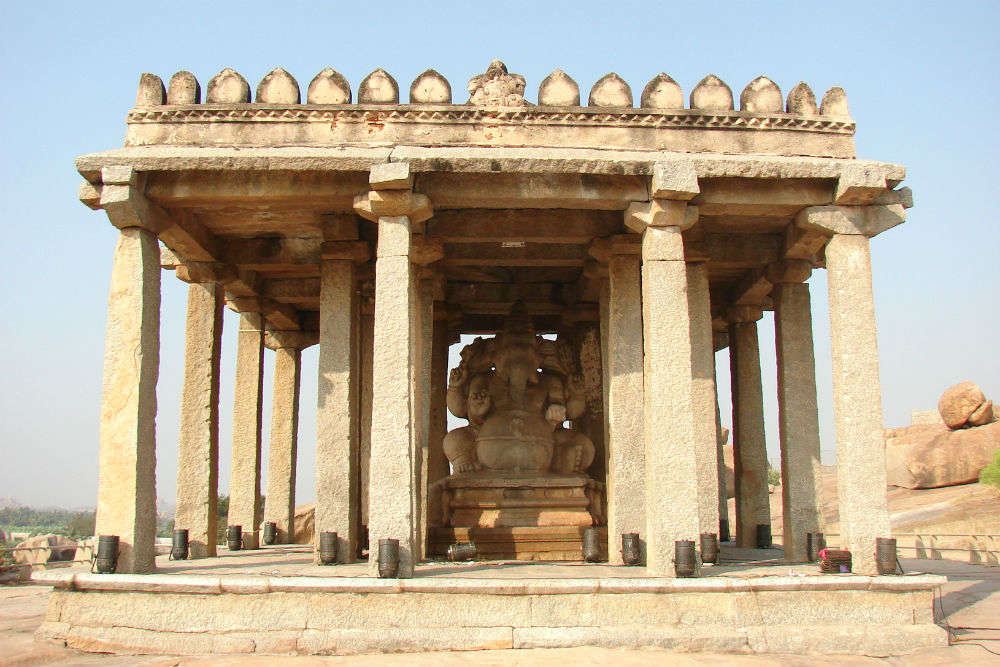
Sculptures of Chola Empire
- The Chola Empire was a Tamil dynasty that ruled primarily in southern India until the 13th century.
- The remarkable Chola sculptures adorned the temple walls in South India. Most of these temples were dedicated to either to Lord Shiva or Lord Vishnu.
- One of the important features of early Chola sculptures then was that the hugeness was missing.
- The main architectural elements that are to be found in the temples of Chola dynasty are garbhagriha, vimana and circumbulatory corridor.
- Rajaraja Chola gave a great boost to the Chola sculptures and architecture. Some of the prominent temples from this period are the architecture and sculpture of Brihadiswara Temple in Tanjore, sculpture of Gangaikonda Cholapuram Temple and the sculpture of Shiva Temple.
- Another important feature of the Chola sculptures was that the sculptures were intricately done. Besides the usual images of gods and goddesses foliage sculpture, perforated windows, animal imageries and others were recurrent motifs as well.
- Apart from the temple sculptures the bronze sculptures thrived too under the Chola kings. The bronze sculptures were created by following the lost wax technique or Cire Perdure. One of the finest examples of bronze Chola sculpture is that of the Nataraja (Lord Shiva in dancing pose).
- In the early Indian scriptures, the Tandava dance has been recorded as cosmic dance. Cosmic dance , as described in Rig-Veda, is the dance of the particles on the stage of the cosmic field.
- The Natyashashtra speaks about the pair of Tandava and Lasya in context with the classical dance. While Power and Force are typical of Tandava, grace and delicacy are typical of Lasya. Lasya was the dance performed by Goddess Parvati in response to the male energy of the cosmic dance of Tandava performed by Lord Shiva.
- Tandava dance of Nataraja represents and symbolises five divine actions viz. Shristi , Sthati, Samhar, Tirobhava and Anugraha. When Nataraja dances, the earth trembles; sky and stars are disturbed by the movement of his powerful hands , at the impact of his whirling matted locks of hair heaven shudders, such is its majesty. The ancient scriptures discuss about seven types of Tandava Dances viz. Sandhya Tandava, Kalika Tandava , Ananda Tandava, Tripura Tandava, Gauri Tandava, Samhara Tandava and Uma Tandava.
- Another majestic example of Tandava dance is mentioned in Mahabharata when Krishna subdued Kalia Nag in Yamuna River, though at the intercession and prayer of Kalia’s serpent- wife he spared the nag’s life. He danced the tandava dance on Kalia’s head and played on flute.
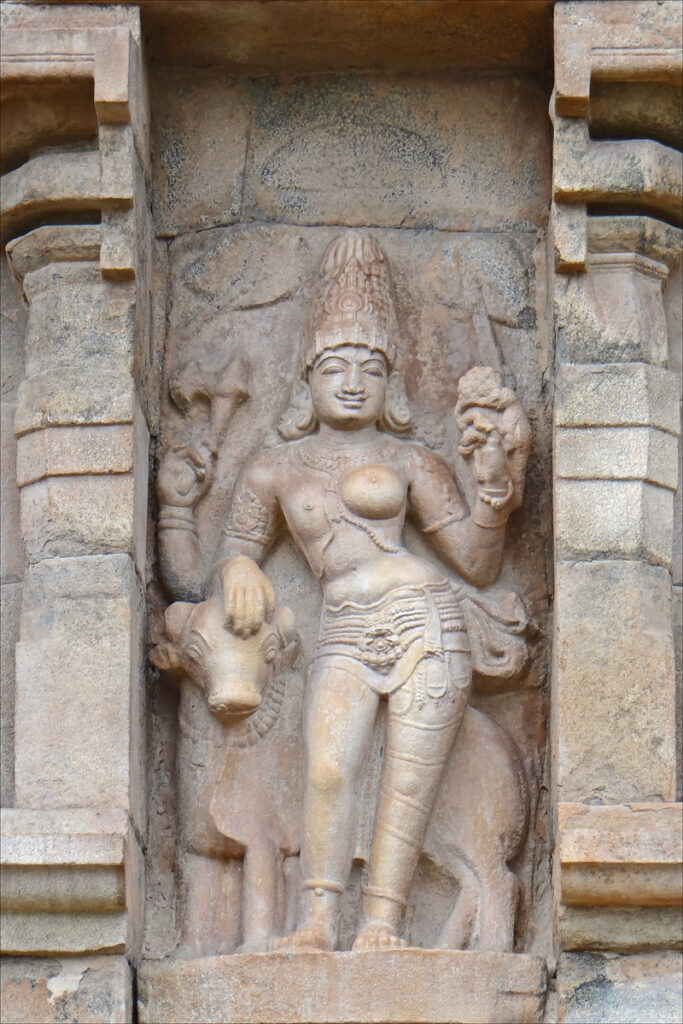
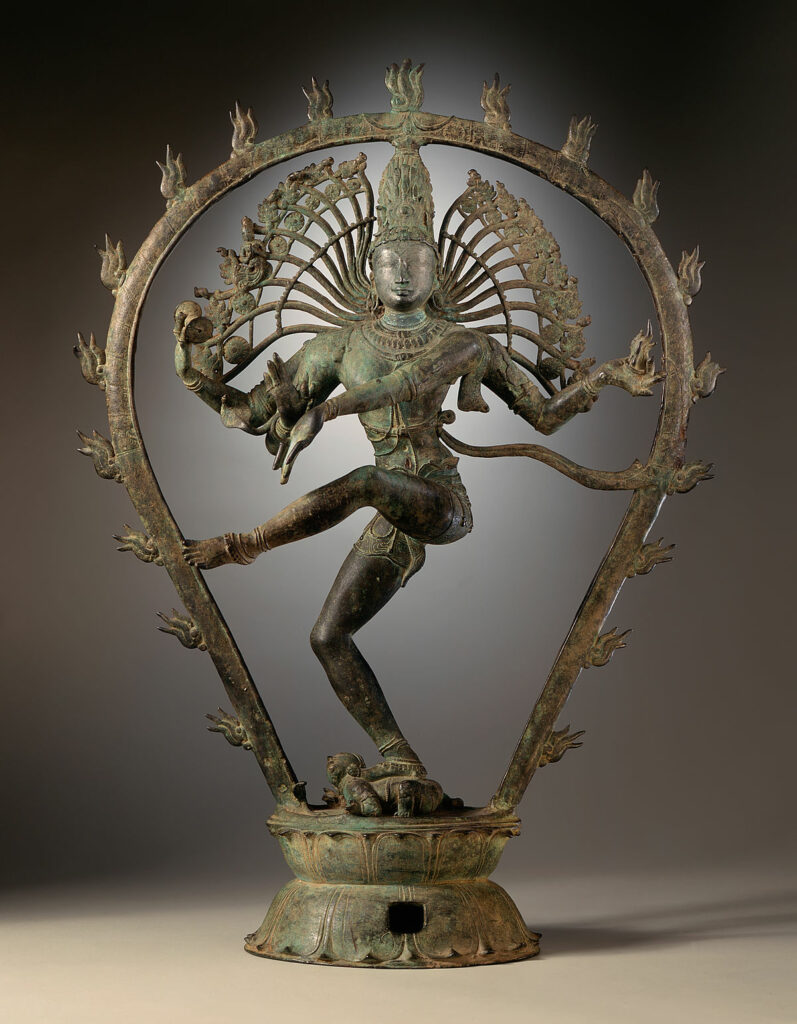
Sculptures of Pallava Empire
- The Pallava dynasty was a South Indian dynasty that existed from 275 CE to 897 CE, ruling a portion of what is today southern India. They gained prominence after the eclipse of the Satavahana dynasty, whom the Pallavas served as feudatories.
- For the first time the stone sculptures, a predominant feature of the South Indian temples, were fast replaced by the innovative rock architecture and sculptures.
- The features of Pallava Sculptures include intricate carvings. Mammoth images were carved out of stone so that the buildings can be dedicated to the deities .
- The Hindu epics were a popular source from which the artisans derived their subjects. These were then retold through the stone sculptures. The sculpture of Kailasanatha Temple at Kanchipuram and the Shore Temple at Mahabalipuram are outstanding examples of art that was carved out of stone during the Pallava reign.
- Pallava bronze sculptures were mostly built from 600 CE to 850 CE . Initially their sculptures were smaller in size. Pallavas developed the Shaivite iconography. They were staunch Saivites and dedicated various forms of Siva in the temple complex.
- Most of the sculptures were less than one foot high and the figures were natural in pose and moulding .
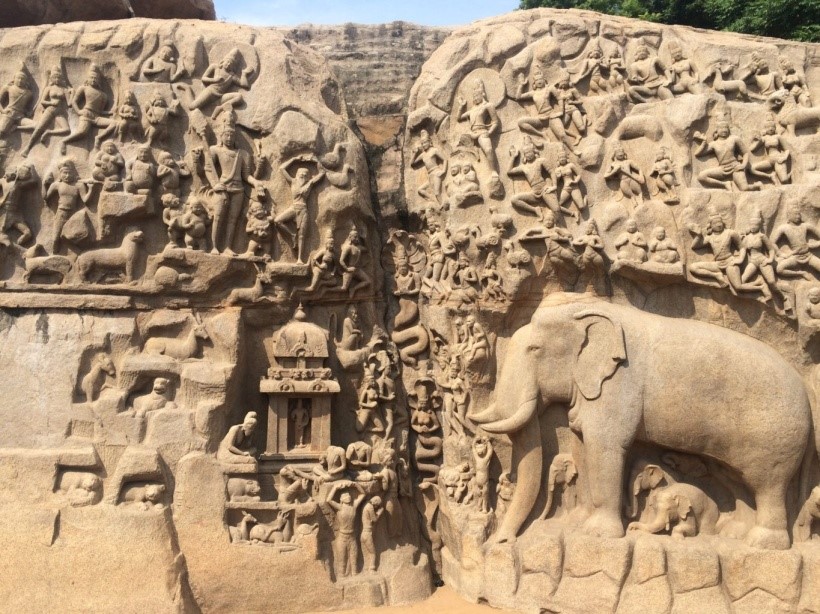
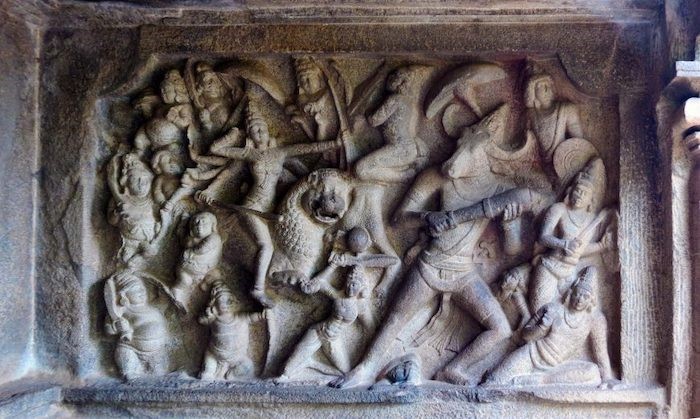
Sculptures of Medieval India
Delhi Sultanate Sculptures
- The Muslim dynasty first came into existence in the 13th century with the Slave dynasty, followed by dynasties that include the Khalji dynasty, Tughluq dynasty, Saiyyid dynasty and Lodhi dynasty. These empires are collectively known as the Delhi Sultanate of India.
- The monuments constructed by these empires strictly followed the features of the Delhi Sultanate sculptures. These characteristics were later amalgamated with the regional sculpture and thus the Indo- lslamic architecture evolved .
- The Sultanate architecture was instrumental in introducing mainly two key features: the domes and the pointed arches and beams .
- With the introduction of this new feature of the amalgamation of Hindu and Islam architecture a new experimentation in the Delhi Sultanate sculpture followed. From time to time new concepts were kept introduced. For example the double domes and enameled tiles.
- Terracotta sculpture remained popular even during the Muslim era.
Mughal Sculptures
- The Mughal sculptures emerged in India during 16th and 17th centuries. This school of architecture brought in the Persian influence on Indian art and architecture.
- Due to an amalgamated style a separate set of features of Mughal sculptures evolved. It was under the Mughal emperor, Akbar that the Mughal art and sculpture truly flourished. The Mughal architecture thus witnessed the construction of some of the most opulent buildings in its history.
- The sculptures during Akbar era comprised calligraphy and thick foliage designs. Architectural elements like domes, chhatris, jharokhas and arched gateways were primarily used. The tradition of constructing grand buildings continued.
- The Mughal monuments are famous for their pristine looks and intricate stone works. The brilliant craftsmanship of the artisans is evident from architectural wonders, such as Taj Mahal, Jama Mosque, the buildings within the Red Fort and others.
- The Mughals also introduced ceramic tile work, Pietra Dura inlay with coloured and semi-precious stones, carved and inlaid stonework. Foliage sculptures in between the arches are outstanding feature too.
- Shallow relief depictions of flowers to intricate pierced-marble screens known as jalis were part of the carved Mughal stone sculptures .
- The Mughal architecture and sculptures reached their zenith under the rule of Shah Jahan.
- One of the most prominent features of Mughal architectures was that it was successful in influencing the native style, especially the Rajput sculpture and architecture.


Modern Indian Sculptures
- The beginning of modernism in Indian sculpture can be traced to its adaptation of western academic art traditions in the early 20th century.
- Sculptures were now created to cater to the demands of the newly emerging upper and middle social classes. The innovation of Indian sculptors can be seen in the intense and exaggerated realism during this period.
- The Indian sculpture got an inspiration of modernity when the British came to rule in India. New trends of Indian sculpture during the pre-independence period emerged out of the influence of European academic realism.
- With the influx of European sculptures and the establishment of art schools, sculpture in India took a new direction. This resulted in what we may call Indo-European style, tackling Indian subjects in European sculptural idiom or making European style of sculptures with Indian sensibilities.
- Prominent modern Indian sculptors include artists such as D. P Roy Chowdhury, Fanindranath Bose, V. P. Karmarkar and Ram Kinker Baij.
